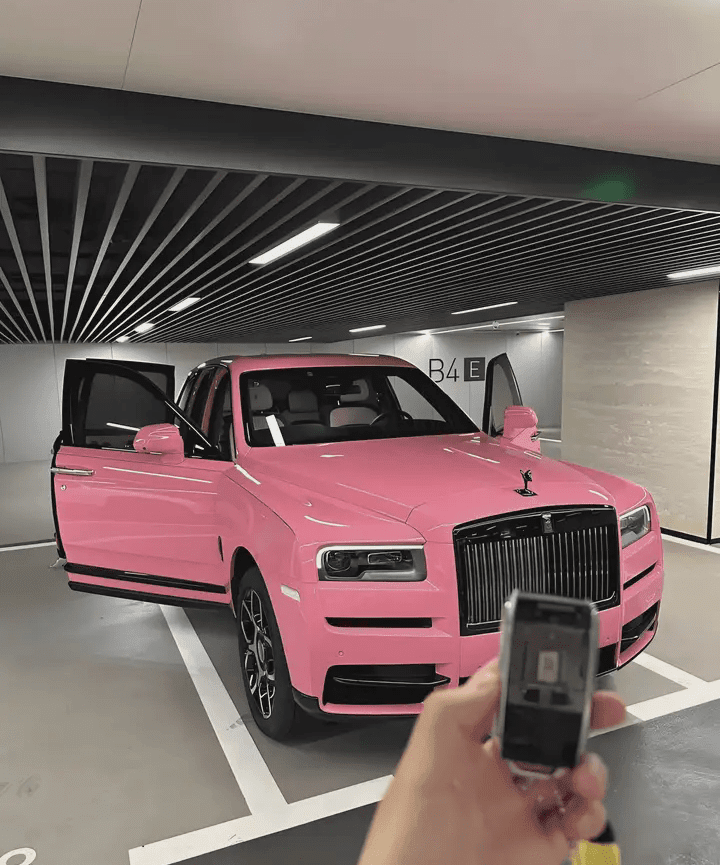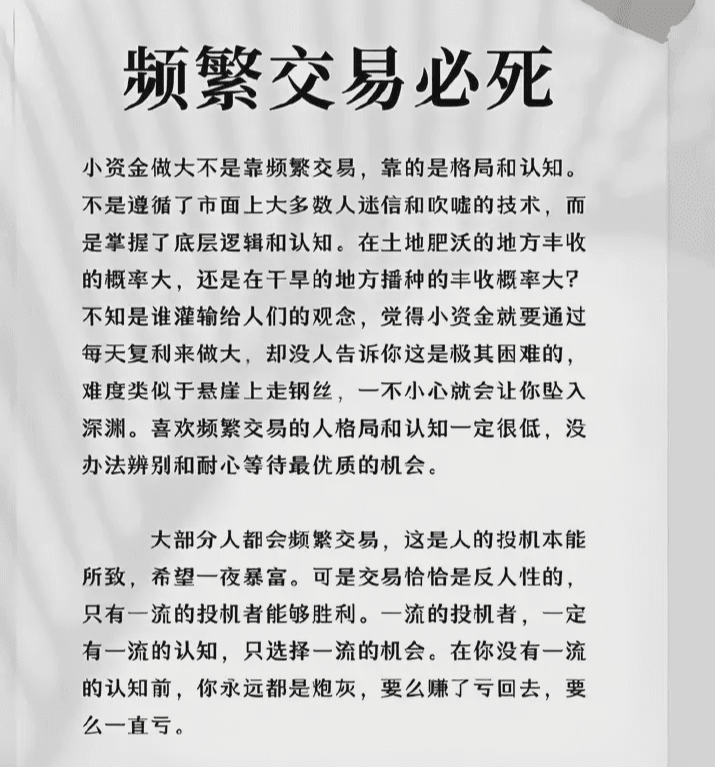Lost 800,000 and then gradually climbed back with 2,000 U! Now trading cryptocurrencies to support my family, with over 34 million in my account!
That year in the bear market, I lost a total of 800,000. During the day I held on, but at night I completely broke down. My social circle cleared out, my contacts were silent, no one understood, and I was left spinning in place. During that time, I really wanted to give up, feeling that the crypto world was too far from me. Until one deep night, I came across a phrase: 'Loss is just the beginning, messing around is the end.' In that moment, I felt like I was awakened.
I took the last 2,000 U I had as my final chip, not to gamble, but to completely start over. I began reviewing my trades one by one, summarizing them line by line, and finally realized: losing money is not just bad luck, but rather that I was never really 'trading'.
Don’t stop losses, go all in, chase rises and kill falls, frequently switch coins, and operate based on emotions! In short, I’m not making strategies; I’m guessing high or low. This time, I’m only doing two things: stabilize the rhythm and enforce execution.
Divide 2000U into three parts: one part for defense, two parts for operation.
Only trade high-certainty markets, taking only 5%-10% profit per trade; take profit when there’s a gain, cut losses immediately; stay in cash when there’s no signal waiting for opportunities.
In the first week, it rose from 2000U to 2900U.
In the second week, the account reached 4300U
In the fifth week, the account successfully broke through 20K+.
That night, I sat in front of my computer in a daze, not because of how much I made, but because I felt for the first time: I really started to turn things around.
Without insider information and without skilled people guiding me, it's just the dumbest rhythm of trading—not impulsive, not heavily invested, only trading markets I can understand. Most people lose money for one reason: chaos. The rhythm is chaotic, emotions are chaotic, plans are chaotic, and in the end, it leads to bigger losses. Actually, as long as you stabilize the rhythm, small funds can also take off. How do I choose points and judge opportunities? Which markets to trade, which to stay in cash? I can only say one thing here; the rest is hard to explain and no one would believe it.
Finally, here’s a saying I like very much: one person walks fast, but a group of people can walk far.


Trading cryptocurrencies relies on cognition and discipline; every penny behind it is a lesson learned through blood and tears!
This market always repeats the same secret: 90% of retail investors stare at news to trade cryptocurrencies, 9% of smart people watch the moves of the big players, while 1% of wolf-like players are dissecting market genes using daily moving averages.
Step 1: Verify the identity of the moving average; treat the daily moving average as three doctors with distinct personalities—5-day line is the head of the emergency department, 30-day line is the internal medicine expert, and 60-day line directly sits in the grand chair of the expert outpatient room.
When the head of the emergency department suddenly perks up and rushes to feel the pulse and examine the two old seniors (the 5-day line crosses above the 30/60-day line), that’s the signal for the market to prepare for ICU rescue. Conversely, if you find the head of the emergency department slipping underfoot, rolling down from the grand chair of the expert outpatient clinic (the 5-day line crosses below the 30/60-day line), don’t hesitate, immediately adjust your position.
Step 2: Establish a trading system to prevent emotional trading.
Now please stick a sticky note on your trading interface, and write in bold with a marker: When moving averages clash, ordinary people should retreat. When the 5-day line and the 30-day line entangle like twisted dough, rushing into the market is equivalent to rolling dice to guess odd or even.
A true hunter only pulls the trigger when three lines are lined up marching in the same direction.
Here’s a counter-intuitive cold knowledge: in the cryptocurrency world where rises and falls are commonplace, the daily moving average warfare is more lethal the simpler it is. Just like real martial arts masters face off, they never use fifty opening moves; a breakthrough of the 5-day line is the signal to draw the sword, while the turning of the 60-day line is the time to sheathe it.
A basic logic: your account is not for betting on the future but for survival. As long as you are still in the game, there is a chance to turn things around.
The six life-and-death lines for retail investors: miss one and you’re out.
1. Taking profits and stopping losses is not a suggestion but a military order that must be executed.
Seeing it right without securing profits is just empty joy; seeing it wrong without stopping loss is opening the gates of hell.
2. Don’t buy at the bottom or sell at the top; the direction of the trend is what’s valuable.
Buying at the bottom and selling at the top is a gambler's behavior; a steady approach is to go with the trend. Low buying doesn’t mean at the lowest point, and selling doesn’t need to be at the highest; just eating the middle part is enough.
3. Rising without volume is an illusion; looking back is just a pitfall.
An increase without trading volume is likely a performance by the main force against the air; don’t be the sacrificial lamb of the audience.
4. React within three seconds of good news; if you miss the first wave, don’t chase the high.
Market opportunities vanish in an instant; being a beat behind means you can only pick up the pieces. If you can’t grab the leading ones, then go layout for the follow-up rise.
5. Rest during consolidating markets; don’t gamble on market conditions.
Ninety percent of the time, the market is volatile, with the main upward wave only occupying a small segment. Don’t rush when you miss the main upward wave; the market will come again.
6. A sharp drop is not despair, it's a signal that opportunity is beginning.
The real bottom always appears in the most panic moments. When others are cutting their positions, you pick up the goods; those who make a fortune are definitely the calm ones.
 Recently, many people have asked me how to operate rolling positions. Is rolling positions really useful?
Recently, many people have asked me how to operate rolling positions. Is rolling positions really useful?
What is rolling positions?
Rolling positions = using small amounts, repeatedly attacking, explosively growing funds in one wave of market.
Does it sound like gambling? No, it’s a combination of controllable risk management + high execution power + market judgment.
The key is two points:
1) The direction must be accurate.
Rolling positions is not betting on fate, but betting on your understanding of the market.
If you do the right direction, rolling positions is just a matter of time.
2) Discipline must be ironclad.
Only take out part of the principal for trading, keep the rest for 'revival';
Take profits when you earn, stop losses when you lose; don’t be greedy, don’t get carried away, don’t move chaotically.
Who is suitable for margin trading?
• Small funds, but want to rely on technology to carve out a path.
• Willing to spend time watching the market, reviewing, and executing.
• Able to be patient, can resist temptation
The suggestion is:
• Set goals: for example, aim for 10,000U, then stop immediately.
• Take profits out, keep only a small position to continue playing.
• Preserving results is more important than anything else.
The three main reasons for total liquidation in contract trading (must self-check):
1. Can't control your hands: watching the market every day, wanting to jump in at every fluctuation, your mindset is completely led by the market.
2. No plan: want to make quick money but haven’t clearly written down stop loss and take profit.
3. Not disciplined enough: made a plan, but as soon as the market moves, completely forget it and directly make emotional trades.
There is only one outcome: liquidation, total loss.
Not everyone is suitable, but if you can achieve calmness + execution ability + accurate direction judgment, then rolling positions truly is the most likely path for ordinary people to turn things around.

Finally, here's a ten-minute guide to understanding the core technology of cryptocurrency trading—must-read for newcomers to avoid pitfalls.
1. First clarify whether you are investing or speculating.
Many new entrants in the cryptocurrency world call themselves 'investors' as soon as they enter, which sounds impressive, but in reality, what you're doing might be 'speculating.'
The distinction is simple:
• Investment: long-term holding, earning from dividends and long-term value returns, such as shareholder dividends and holding shares of quality companies.
• Speculation: Short-term entry and exit, making profits by buying low and selling high or selling high and buying low, having little to do with the long-term development of the project.
If you want to invest, then choose a project you recognize, give the money to the project party, and wait patiently without worrying too much about the ups and downs.
But if you want to trade cryptocurrencies, you must recognize the reality—what we are doing is speculation, making money off market fluctuations, not falling in love with projects.
2. How to view the market without getting lost
Since it’s speculation, the goal is to understand price fluctuations and find opportunities within.
There are many patterns in technical analysis, but fundamentally they all revolve around four core elements: price, trading volume, time, and news; essentially, they are all studying one thing—human nature.
1. Price (K line)
A K-line records the opening price, closing price, highest price, and lowest price for a certain period.
• The upper and lower ends of the candlestick body are the opening and closing prices.
• The upper shadow line is the highest transaction price for that period.
• The lower shadow line is the lowest transaction price.
Note:
In the domestic market, red generally represents an increase, and green represents a decrease; while in foreign markets and cryptocurrencies, the common market system is just the opposite—red means a decrease, green means an increase. Make sure not to confuse them when watching the market.
2. Trading volume
The bars below the trading interface represent trading volume. The higher the bars, the more active the trading during that period. Trading volume combined with price changes can judge the real strength of the market.
3. Moving Average (MA)
Average the closing prices of several cycles, then connect them with a line to get the moving average.
• Short-term moving average crosses above long-term moving average → Trend is bullish.
• Short-term moving average crosses below long-term moving average → Trend is bearish.
Many traders rely on a moving average to make a living; all complex indicators are almost derived from it.
4. MACD
A slightly more complex trend indicator than a moving average, able to judge the strength of the market and potential reversals.
• Short-term moving average crosses above long-term moving average → Bullish
• Short-term moving average crosses below long-term moving average → Bearish.
• Special situations are 'top divergence' and 'bottom divergence,' which have a relatively high hit rate but are not suitable for volatile markets.
3. The truth about technical indicators
KDJ, BOLL, RSI, W&R… these indicator names sound impressive, but they can’t escape one fact—they are fundamentally mathematical calculations, and math cannot perfectly portray human nature.
I was once obsessed with various indicators, even writing over a hundred quantitative strategies with back-test accuracy reaching 90%, but once I entered real market conditions, the effect began to discount.
Some simple indicators have only a 60% success rate, but combined with money management, they can handle most market situations.
Many top quantitative trading systems are like this—huge amounts of code, countless models, but their actual performance is far less stable than expected. The reason is simple: human nature is the biggest variable; any indicator can only approach it but cannot predict it completely.
4. The correct way to open technical analysis
Technical indicators are not a universal holy grail, but they can help us:
• Filter out some uncertain market situations.
• Provide reference for buying and selling
• Make decisions more structured, rather than relying on emotional impulses.
My suggestion is:
1. Choose 1-2 simple and easy-to-understand indicators to use repeatedly.
2. Combine price and trading volume, first learn to judge trends.
3. Don’t be dazzled by flashy indicators; indicators are just aids, execution is the core.
Conclusion
The key to making money in the cryptocurrency circle is not finding an 'all-success' indicator but understanding the logic behind the indicators and combining it with money management and execution discipline.
Remember this: market prediction is not important; execution is what matters.
I am Xiao Yue, a professional analyst and teacher, a mentor and friend on your investment journey! As an analyst, the most basic thing is to help everyone make money. I will help you solve confusion, avoid traps, and speak with strength. When you lose your direction and don’t know what to do, follow Xiao Yue; I will point you in the right direction.
#币安HODLer空投XPL $ETH


